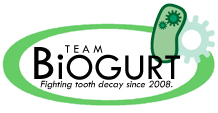Team:MIT
From 2008.igem.org
| Line 25: | Line 25: | ||
| | | | ||
'''Welcome to the MIT team Wiki for iGEM 2008''' | '''Welcome to the MIT team Wiki for iGEM 2008''' | ||
| - | *'''iGEM''' is the international | + | *'''iGEM''' is the international Genetically Engineered Machines competition. |
*The objective of the competition is to design and build an engineered biological system using [http://en.wikipedia.org/wiki/DNA DNA]. | *The objective of the competition is to design and build an engineered biological system using [http://en.wikipedia.org/wiki/DNA DNA]. | ||
*To see examples of the '''amazing possibilities''' of iGEM, check out last years [http://parts.mit.edu/igem07/index.php/Main_Page iGEM page] | *To see examples of the '''amazing possibilities''' of iGEM, check out last years [http://parts.mit.edu/igem07/index.php/Main_Page iGEM page] | ||
Revision as of 15:49, 25 June 2008
Project DescriptionOur goal is to engineer yogurt to prevent cavities. Teeth are covered in a complex biofilm containing many types of bacteria and glycoproteins. Of all the bacteria found in the biofilm, only one strain, Streptococcus mutans is proven to be harmful. S.mutans attatches to a glycoprotein in the biofilm, forms colonies, takes in sugars, and secretes lactic acid which breaks down the enamel of the teeth, causing dental cavities. A clinical study (Kelly CG et al.; Nature Biotechnol. 1999) isolated the protein that S.mutans uses to attach to the teeth and isolated the 20aa functional segment (p1025) that actually binds to the glycoproteins. p1025 competitively inhibits the binding of S.mutans, causing other (unharmful) bacteria to grow in its place. This was found to prevent the recolonization of S.mutans for about 90 days. We are engineering Lactobacillus bulgaricus, a bacteria commonly found in yogurt, to produce this peptide. Although the peptide could be commercially added to the yogurt, since production of this peptide by L. bulgaricus is independent, this mechanism will enable continuous production and remove the need for continuous addition of the peptide. Since a new batch of yogurt is made by using the bacteria from a small saved amount of the old batch, a continuous supply of teeth-cleaning yogurt will be made available immediately once the first batch is successfully engineered. The implications for such a biological system are enormous as it could revolutionalize dental health care around the world. This creation is applicable to and useful for all people; most importantly this could be the key to surpassing concerns of cost and availability of necessary and effective dental health care in small-scale, underdeveloped rural communities. | |||||||||
|
| |||||||||
| Home | The Team | The Project | Parts Submitted to the Registry | Modeling | Notebook |
|---|
 "
"

